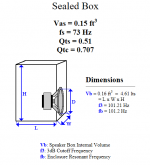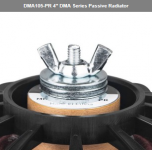Dayton Audio DMA105-PR 4" DMA Series Passive Radiator - DMA Series - Loudspeaker Drivers By Series - Loudspeaker Components
Dayton Audio DMA105-8 4" Dual Magnet Aluminum Cone Full-Range Driver 8 Ohm - DMA Series - Loudspeaker Drivers By Series - Loudspeaker Components
I would like to design a speaker comprised of the 2 above on 2 ends
of a 4 " ( dia. ) ABS pipe .
I need help calculating the length .
Dayton Audio DMA105-8 4" Dual Magnet Aluminum Cone Full-Range Driver 8 Ohm - DMA Series - Loudspeaker Drivers By Series - Loudspeaker Components
I would like to design a speaker comprised of the 2 above on 2 ends
of a 4 " ( dia. ) ABS pipe .
I need help calculating the length .
The general rule of thumb is to select a passive radiator that covers about twice the displacement of the selected woofer. That usually means a PR about twice the size of the woofer or 2 similarly sized PRs as the woofer. Check out the following link to help you with calculations: The Subwoofer DIY Page - Passive Radiator Systems
Looking at the spec sheets you provided raises a couple of questions:
1. Does Xmech = Xmax when calculating displacement values?
2. Is Xmax on your woofer a one-way or two-way measurement?
You may have to ask Parts Express to get a definitive answer.
Looking at the spec sheets you provided raises a couple of questions:
1. Does Xmech = Xmax when calculating displacement values?
2. Is Xmax on your woofer a one-way or two-way measurement?
You may have to ask Parts Express to get a definitive answer.
Last edited:
Hi CraigSu!
I'm not an expert regarding PRs so just running the following figures past you for comment.
As a general rule, the passive radiator should have at least double the displacement of air (Vd) as the working woofer.
In the Dayton examples, after looking at their specification sheets:
Woofer: Vd = 13.5cm^3
Passive radiator: Vd = 48.7cm^3
So, is the Vd criterion fulfilled?
If so, the question remains - what volume should the pipe have?
I'm not an expert regarding PRs so just running the following figures past you for comment.
As a general rule, the passive radiator should have at least double the displacement of air (Vd) as the working woofer.
In the Dayton examples, after looking at their specification sheets:
Woofer: Vd = 13.5cm^3
Passive radiator: Vd = 48.7cm^3
So, is the Vd criterion fulfilled?
If so, the question remains - what volume should the pipe have?
Hi CraigSu!
I'm not an expert regarding PRs so just running the following figures past you for comment.
As a general rule, the passive radiator should have at least double the displacement of air (Vd) as the working woofer.
In the Dayton examples, after looking at their specification sheets:
Woofer: Vd = 13.5cm^3
Passive radiator: Vd = 48.7cm^3
So, is the Vd criterion fulfilled?
If so, the question remains - what volume should the pipe have?
That makes 2 of us who aren’t PR experts! I see Xmech quoted more often than Xmax with PRs and I’ve wondered why since it doesn’t help to have different terms used to (potentially) describe the same unit of measurement. If Xmech really does equal Xmax and they are both measured equally (i.e., both are being reported as one-way or two-way) then the Vd calculations are apples to apples and the OP’s choice of PR should work. If not, then he’s going to need a cabinet that isn’t a straight length of equal diameter pipe at both ends.
Looking at the PE webpage for the PR (Dayton Audio DMA105-PR 4" DMA Series Passive Radiator) it uses Xmax to describe the travel as opposed to the spec sheet linked by the OP which uses Xmech. Both are quoted as 9mm so it’s likely they mean Xmech = Xmax, at least in this case.
The Parts Express' figure for the volume of a suitable vented enclosure suggests that the pipe would have to be 130cm long, which may not be aesthetically pleasingI would like to design a speaker ... 4 " ( dia. ) ABS pipe.
I need help calculating the length .
However, at least this would provide a suitable starting point for experimentation when incorporating the passive radiator.
Thank You All ! : )
Yes
I tried a crude stab and came up with ~ 4 '
I'd like a tabletop and could live with down
to ~ 100 Hz
I like those drivers , I think the high Qts
makes the Vb need to be so large.
Maybe some weird alignment or ?
Or larger diameter pipe ( rarer and bigger $ )
Yes
I tried a crude stab and came up with ~ 4 '
I'd like a tabletop and could live with down
to ~ 100 Hz
I like those drivers , I think the high Qts
makes the Vb need to be so large.
Maybe some weird alignment or ?
Or larger diameter pipe ( rarer and bigger $ )
Last edited:
I'm not sure if my simulations were correct, but that driver seems to need a big enclosure to work properly? I didn't get any good results with that PR, but with standard bass reflex enclosure, the volume was about 10 liters to get a good looking frequency response. That will be a long pipe...
Is there a reason why you chose those drivers? Is it possible to change? For example, Dayton Audio ND91 would fit into a 1,5 liter bass reflex enclosure. Of course you wouldn't get the lowest notes from it, but it's still a pretty impressive driver for it's size!
Is there a reason why you chose those drivers? Is it possible to change? For example, Dayton Audio ND91 would fit into a 1,5 liter bass reflex enclosure. Of course you wouldn't get the lowest notes from it, but it's still a pretty impressive driver for it's size!
Is there a reason why you chose those drivers? Is it possible to change?
1) Open backs - small magnets - nice looking from rear
I want to try a 'mini-Walsh' approach
( Driver down-firing - listen from rear )
2) Matching drone-cones
Since my cab will be a straight pipe I can mount both
the driver and drone with long nuts / bolts through the
whole assembly.
3) Yes ….. I could change
Addendum : The 3 " version of these drivers has lower Qts
making for a quite more pipe friendly device ...
Hmm ,Hmm, ~72 Hz driver, ~ 38 Hz PR means it auto tunes to 38 Hz, hence a very poor match to the driver.Might as well make the tube 10x Vas and seal it for IB.
GM
Maybe not quite IB , and I wanted smaller , but 2 ' ain't that bad :
You think the PR couldn't be adjusted enough ? :
DMA80-PR 3" DMA Series Passive Radiator Specification Sheet
Attachments
Last edited:
DMA80-PR 3" DMA Series Passive Radiator Specification Sheet
There's a wing nut on the bottom (top?) that supposedly adjusts mass .
( It would have to be ' effective mass ' or another parameter with equivalent results )
" Rear mounted threaded post allows easy mass adjustment for custom tuning "
Unless they mean use it to add washers for weight or ?
There's a wing nut on the bottom (top?) that supposedly adjusts mass .
( It would have to be ' effective mass ' or another parameter with equivalent results )
" Rear mounted threaded post allows easy mass adjustment for custom tuning "
Unless they mean use it to add washers for weight or ?
Attachments
Last edited:
I bought and utilized some of the Dayton 2" passive radiators, and with those they arrived with the wing nut holding three washers on the back of it, so one could subtract washers from 'stock' and also have room to add more, or larger, washers to add more mass than stock. Tend to assume that the design might carry over to at least some of the other Dayton PRs
Would you share your design ?I bought and utilized some of the Dayton 2" passive radiators, and with those they arrived with the wing nut holding three washers on the back of it, so one could subtract washers from 'stock' and also have room to add more, or larger, washers to add more mass than stock. Tend to assume that the design might carry over to at least some of the other Dayton PRs
Did you do any sims or ?
I've been trying this :
HiFi Loudspeaker Design
And can't arrive at anything realistic ….
- Status
- This old topic is closed. If you want to reopen this topic, contact a moderator using the "Report Post" button.
- Home
- Loudspeakers
- Full Range
- Dayton passive radiator design

